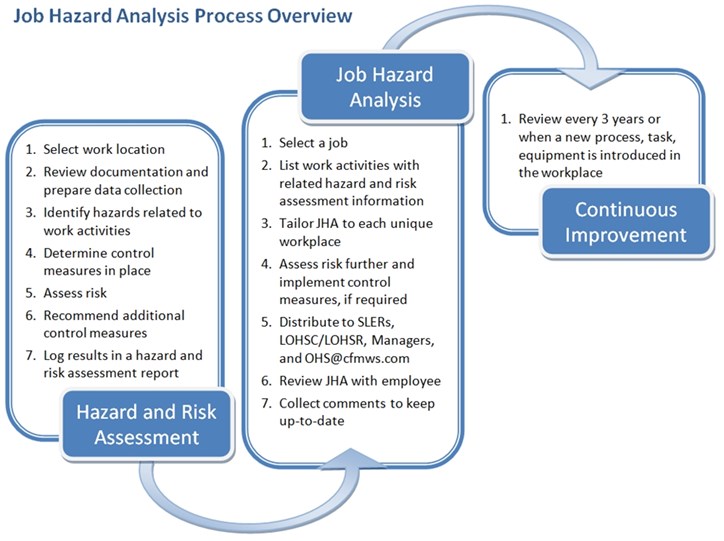Occupational Health and Safety
Reporting Accidents
Attention: All employees MUST report work related incidents/accidents to their supervisor/manager as soon as possible using SMAAT.
A Guide to Employees - What to do if you are injured at Work
Report accidents, inspections, corrective measures, and access the admin login.
Privacy Notice
Personal information is collected pursuant to the section 240 of the Public Service Labour Relations Act, Part II of the Canada Labor Code and Part XV and Part XVI of the Canada Occupational Health and Safety Regulations, and the Government Employee Compensation Act. The information is used to administer occupational safety and health activities, including occupational injuries and illness and, where applicable, the investigation of occurrences of such injuries and wellness.
Personal information is protected, and only used and disclosed in accordance with the provision of the Privacy Act and as described in personal information bank PSU 907 Occupational Health and Safety. Under the Act, individuals have rights of access to and correction of their personal information, and the right to file a complaint to the Privacy Commissioner of Canada regarding the institution’s handling of personal information.
If you require clarification about this statement, contact our privacy coordinator. For more information on the Privacy Act, consult the Office of the Privacy Commissioner of Canada.
TOOLS
OHS Mandatory documenting after an incident/accident
Injury Flowchart
List of address to send HOIR - Lab 1070
List of SLERs
OHS Incident Report for Non-Employees
If you are injured
REFUSAL TO WORK
Internal Complaint Resolution Process
Right to Refuse Dangerous Work Process
Refusal to Work Investigation Employer Report
Refusal to Work Registration
OHS representatives and legislation
Location to enter the details of a new inspection:
OHS Committee/Representatives Inspections
WHMIS Electronic Binder - PARATOX
Senior Local Employer Representatives by NPF Location
Prevention
More information and resources: Canadian Centre for Occupational Health and Safety (CCOHS)
Emergency Preparation, Response and Evacuation
Emergency Preparation, Response and Evacuation Program
Occupancy Emergency Plan
Employees Working Alone
Employees Working Alone Program
Employees Working Alone Safely Guide
Employees Handling Cash and Working Alone Security Checklist
Employees Performing Hazardous Work and Working Alone Security Checklist
Ergonomics
Ergonomic Program
Ergonomics and Wellness
Ergonomics Guide
Ergonomic Poster
Workstation Ergonomics: Adjusting your Workstation
Working in a Standing Position - Basic Information
Working in a Sitting Position
Request Ergonomic Assessment Form
Creating a Comfort Zone: Ergo-friendly on the Job
Ergonomics associated with Manual Handling Practices
Preventing Multiple-Strain Injuries - Working with Office Computers
Workstation Ergonomics: Exercises at your Computer
Recommended Physical Exercises for Computer Users
Ergonomic Risk Factors Office Work
Telework Safety Checklist
Working From Home Ergonomics
Equipment Safety
Playspace and Equipment Maintenance Program
Playspace and Equipment Maintenance Checklist
Fire Prevention
Fire Prevention Program
Fire Warden Responsibility - Record of Acknowledgement
Action to be Taken during Shutdown of Fire Safety Equipment - Notice Alert
Prevention of Fire Hazards Notice Alert
Fire Emergency for Building Occupants Poster
If you Detect Fire Poster
First Aid and Cardio Pulmonary Resuscitation
First Aid and Cardio Pulmonary Resuscitation Program
First Aid Kit Requirements
First Aid Kit Contents
Food Safety
Food Safety Program
Hygiene and Sanitation Control Measures
Hazardous Substances
Hazardous Substances Program
WHMIS Electronic Binder - PARATOX
PARATOX Inventory Template
General Safety Precautions in case of a Spill of Hazardous Substances
WHMIS Symbols 2015
WHMIS Symbols 1988
Asbestos Guide - Frequently Asked Questions
Hazard Prevention
Job Hazard Prevention Program
Job Hazard Analysis
A Job Hazard Analysis (JHA) is a process that:
- offers a step-by-step approach to recognize, assess and control hazards, and monitor the ongoing effectiveness of controls
- systematically evaluates certain jobs, tasks or processes
- helps to eliminate or reduce risks or hazards in order to protect workers from injury or illness

Generic JHA
Instructions
Mess - Bartender 2017/03/01
Mess - Caterer/Server 2017/03/01
Mess - Server 2017/03/01
Pool - Lifeguard/Swim Instructor 2017/01/27
Rec. Center - Recreation Leader 2017/03/23
Rec. Center - Instructor, Children Program Exercise 2017/03/23
Rec. Center - Instructor, Arts and Crafts 2017/03/23
Gym - Fitness and Sports Instructor 2017/05/24
Heat Stress
Heat Stress Guide
Heat Stress Poster
Heat Stress Tool
Inspection Checklists
Inspection Manual
Inspection Manual - Quick Reference Cards
Barber and Beauty Shop Checklist
Fire Prevention and Control Measures Checklist
General Physical Conditions Checklist
Playspace and Equipment Checklist
Swimming Pool Checklist
Food Premises Monthly Checklist
Personal Protective Equipment
Personal Protective Equipment Program
Protection - Safety Guidelines
Safe Work Practices
Cleaning Bodily Fluids
Training
NPF Occupational Health and Safety (OHS) Training
Step 1: Log on to your DLN account.
Step 2: Select the course you wish to take from the list below.
Online Learning
| Online Learning | Duration | Audience |
| NPF Occupational Health and Safety, Awareness for Employees | 30 min | All employees, including Managers/Supervisors |
| NPF OHS Awareness for Managers and Supervisors | 30 min | Managers/Supervisors |
| NPF - WHMIS | 90 min | All employees, including Managers/Supervisors |
| NPF - Introduction to the Canadian Labour Code Part II | 30 min | SLER, LOHSC Co-Chairs, LOHSR |
| NPF - SMAAT for Employees | 5 min | All employees, including Managers/Supervisors |
| NPF-SMAAT for SLERs, LOHSC Co-Chairs and LOHSRs | 30 min | SLER, LOHSC Co-Chairs, LOHSR |
| NPF-SMAAT for HR Managers, Coordinators and Assistants | 30 min | HR Managers, Coordinators and Assistants |
| NPF OHS Accident Report Tutorial | 30 min | SLER, HR Managers |
Alternate Delivery Tool - Seasonal, Casual and Student Employees Only
| Title/Description | Duration | Audience |
| 30 min | Managers/Supervisors | |
| 50 min | Managers/Supervisors |



